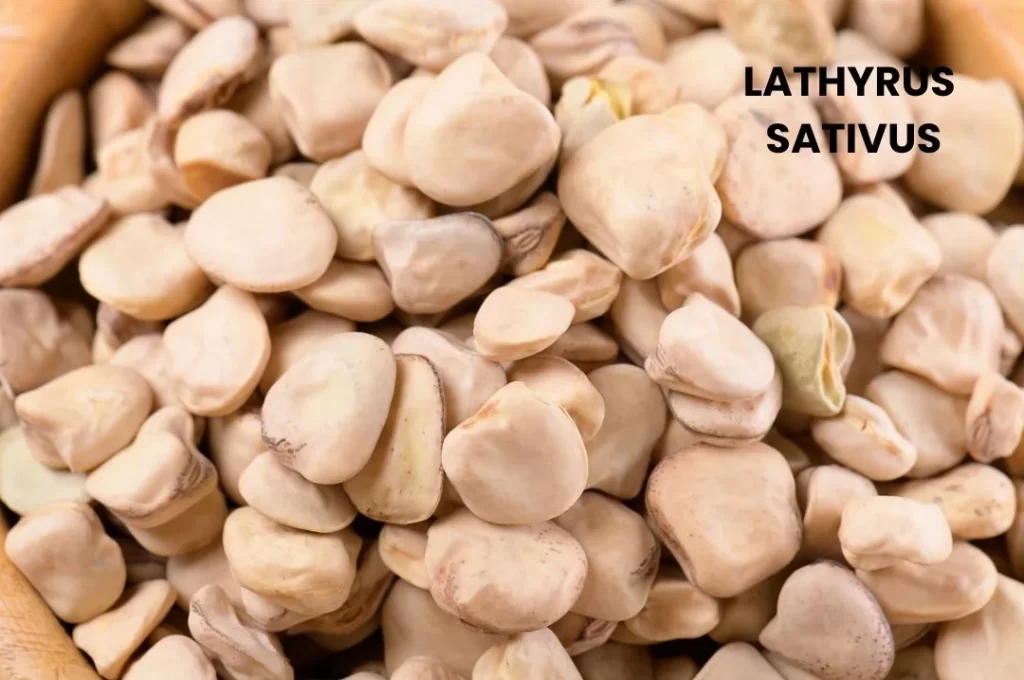Lathyrus Sativus, commonly known as chick-pea, is a homeopathic remedy that primarily affects the nervous system, especially the spinal cord.
It is used for various neurological and paralytic conditions, with a special focus on the lower extremities.
This remedy is particularly beneficial for conditions that involve spastic paralysis, lateral sclerosis, and other forms of muscular and nerve debility.

Table of Contents
ToggleSOURCE INFORMATION
- Common Name: Chick-pea
- Scientific Name: Lathyrus sativus
Scientific Classification
- Family: Fabaceae
- Genus: Lathyrus
- Species: Lathyrus sativus
Origin and Historical Facts
- The chick-pea plant is native to the Mediterranean region and parts of Asia.
- Historically, Lathyrus sativus has been recognized for its nutritional value and its role in food security during famines.
- However, its seeds contain a neurotoxin that can cause a condition known as lathyrism, which affects the nervous system.
- This property is harnessed in homeopathy to treat various neurological disorders.
KEY CHARACTERISTICS
- Affects Spinal Cord: Specifically targets the lateral and anterior columns of the spinal cord.
- Increased Reflexes: Reflexes are heightened, which can lead to spastic conditions.
- Paralytic Affections: Especially in the lower extremities, causing spastic paralysis and related conditions.
- No Pain: Symptoms are not typically associated with pain.
- Post-Influenza and Exhaustive Diseases: Useful in conditions following influenza or other debilitating illnesses that result in weakness and slow recovery of nerve power.
- Constant Yawning: Indicative of underlying neurological exhaustion.
DETAILED ORGAN SYMPTOMS
MIND
- Depression: Feelings of sadness and hypochondriacal tendencies.
- Vertigo: Dizziness, especially when standing with eyes closed.
MOUTH
- Burning Pain: Sensation of burning at the tip of the tongue.
- Tingling and Numbness: Tongue and lips feel numb and tingly, as if scalded.
EXTREMITIES
- Numbness: Tips of fingers feel numb.
- Gait Issues: Tremulous and tottering gait, excessive rigidity of legs leading to a spastic walk.
- Knee Problems: Knees knock together when walking.
- Leg Cramps: Worsened by cold and accompanied by cold feet.
- Paralysis: Involves the lower limbs, with symptoms of stiffness and lameness in ankles and knees. Patients have difficulty extending or crossing their legs when sitting.
- Muscle Wasting: Particularly affects the gluteal muscles and lower limbs, which may appear blue and swollen if legs hang down.
- Toe and Heel Issues: Toes do not leave the floor and heels do not touch the floor while walking, indicating severe spasticity.
- Posture Problems: Patients sit bent forward and have difficulty straightening up.
URINE
- Bladder Reflex: Increased reflex leading to frequent urination and urgency, sometimes resulting in involuntary urination.
RELATIONSHIP WITH OTHER DRUGS
Compare with
- Oxytropis: Known for its paralytic symptoms and neurological effects.
- SECALE CORNUTUMSecale: Used for conditions involving gangrene, spasms, and coldness.
- Petiveria: South American plant used for paralysis and paraplegia with numbness and a sensation of internal coldness.
- Agrostemma githago (Corn-cockle): Known for burning sensations in the stomach, esophagus, lower abdomen, and anus, along with nausea, vomiting, impaired locomotion, and vertigo.
DOSE
- Potency: Third potency is commonly used.
Frequently Asked Questions (FAQs)
What conditions is Lathyrus Sativus used for in homeopathy?
- Lathyrus Sativus is primarily used for neurological and paralytic conditions, especially those affecting the lower extremities, such as spastic paralysis, lateral sclerosis, and post-influenza debility.
How does Lathyrus Sativus affect the nervous system?
- It targets the lateral and anterior columns of the spinal cord, leading to increased reflexes and spastic conditions without causing pain.
Can Lathyrus Sativus be used for urinary issues?
- Yes, it can help with increased bladder reflex, leading to frequent urination and urgency.
What are the key symptoms indicating the use of Lathyrus Sativus?
- Key symptoms include spastic paralysis, numbness in fingers, tremulous gait, knee problems, muscle wasting, and urinary urgency.
How is Lathyrus Sativus administered?
- Lathyrus Sativus is administered in the third potency.
Glossary of Difficult Words
- Lateral Sclerosis: A condition affecting the lateral columns of the spinal cord, leading to muscle weakness and spasticity.
- Athetosis: A condition characterized by involuntary writhing movements, typically of the hands and feet.
- Myelitis: Inflammation of the spinal cord.
- Hypochondriacal: Excessive worry about having a serious illness.
- Cramps: Sudden, involuntary muscle contractions causing pain.
- Spasticity: A condition where muscles are continuously contracted, causing stiffness and tightness.
- Paraplegia: Paralysis affecting the lower half of the body.
- Neurotoxin: A toxin that affects the nervous system.
- Lathyrism: A neurological disease caused by consuming large amounts of Lathyrus sativus seeds, characterized by paralysis and muscle wasting.
